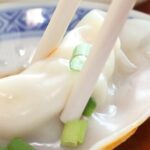
The Guide to Different Types of Chinese Dumplings
One of the staples of Chinese cuisine has become an international phenomenon, and dumplings have become an icon of good, tasty, and inexpensive food. You’ve almost certainly had a Chinese dumpling before, whether it be out celebrating with friends, enjoying a work lunch, or just having a simple meal at your favourite noodle restaurant.
Most people have an idea what a Chinese dumpling looks and tastes like, but not as many realise their rich history which has lead to how varied and exciting these tasty treats can be. Here are just some of the most popular dumpling varieties from all over China for all types of occasions, offering something to please every palate.
Steamed dumplings
A light and healthy option, steamed dumplings are the perfect pick-me-up for breakfast and equally enjoyable at all times of the day (or night).
- Shao Mai – The classic image of the 'Chinese dumpling,' Shao Mai may have originated in Mongolia, but it's the white-skinned Hong Kong variety that's best known worldwide, with fillings that vary according to the season. These are famously compared to biting into a soufflé, because the dumpling is soft and puffy.
- Shanghai Steamed Buns – Don’t let the name confuse you. These aren’t actually buns at all. Rather, they feature a filled wrapper that is gathered up into several folds before steaming, and this cooking technique means that they are full of flavour and very, very juicy.
- Xiaolongbao – Instantly recognisable for their cubed shape, these ubiquitous dumplings are typically filled with pork and a rich broth. Just be careful when biting into them that the broth doesn’t spill out everywhere!
- Momo – Whether you're vegetarian or prefer beef, mutton, pork, chicken or traditional yak meat, any filling goes in these purse-shaped dumplings of Tibetan and Nepalese origin, as long as you don't skip on the fiery sepen dip.
- Har Gow – These dumplings are famous for being translucent; cooked well you’ll see pieces of shrimp inside. Despite looking flimsy, though, they will be sturdy, and have a slightly chewy but not tough texture to chew.
Boiled dumplings
Poached and boiled dumplings offer even more diverse flavour combinations, both savoury and sweet.
- Shui Jiao – Literally 'boiled dumpling,' this northern Chinese staple is similar to a wonton without the soup. Just as varied as the flavours available are the different textures that each filling brings.
- Jiaozi – These crescent-shaped dumplings with pleated edges are generally filled with meat or vegetables, though more unusual ingredients such as shrimp and winter melon are popular choices too. They can be pan-fried, but are typically boiled, and use a flour and water dough that is thicker than wonton wrappers.
- Hun Tun – Known as wonton in Cantonese, where they feature a plump shrimp filling served in egg noodle soup, the most widespread variety of Hun Tun is filled with minced pork and bok choy (Chinese cabbage) or watercress.
- Tang Yuan – Their name translates as 'soup spheres,' which is an apt description of these sweet dumpling balls. Typically filled with red bean, peanut and black sesame, the recipe is easily adapted to suit local tastes wherever you are in the world – from mango and pineapple fillings to chocolate. Just be aware that they can be very sweet! Also, drink the soup after eating the sweets. That soup brings with it the promise of happiness.
- Qing Tuan – You’ve never seen dumplings like these before. Qing Tang have a rich, green-coloured appearance, and are as healthy to eat as they look; they’re typically filled with green ingredients. They can be served sweet or savoury, with black sesame being a particularly popular flavour.
Fried dumplings
Pan-fried and deep-fried dumplings are a little heavier on the stomach, but can work wonders as comfort food and tasty appetisers.
- Guo Tie – A pan-fried alternative to Shui Jiao made with a thicker skin, Guo Tie are traditionally filled with pork and cabbage or leek. They’re famously known as ‘potstickers’ in English, as a literal translation, so if you see that word used to describe a dumpling, this is what you’re looking at.
- Jiu Cai Bau – These rounded dumplings are pan fried to give them a blistered crust, and are filled with peppery chives for a real hit of flavour. For extra visual effect, these dumplings are usually filled so far that the ingredients poke out of the top.
- Sheng Jian Bao – There are two versions of Sheng Jian Bao – a steamed version, and a fried version. The fried version is a popular breakfast food and snack, thanks to its crispy base texture, and the slightly thicker dough, which helps to keep the flavours and juices in.
- Fried wonton – Deep-fried wontons dipped in sweet and sour sauce are a favourite appetiser on international Chinese menus.
Mouth-watering dumplings at Marketplace Gungahlin
Next time you're in Canberra and looking to eat one of China’s most traditional dishes, head to Marketplace Gungahlin for the best dumplings in town.
Jade Dumpling Noodle House has a wide selection of dumplings, noodles, stir-fries, curries and other favourite Chinese and Asian dishes, for takeaway or dining in seven days a week.

